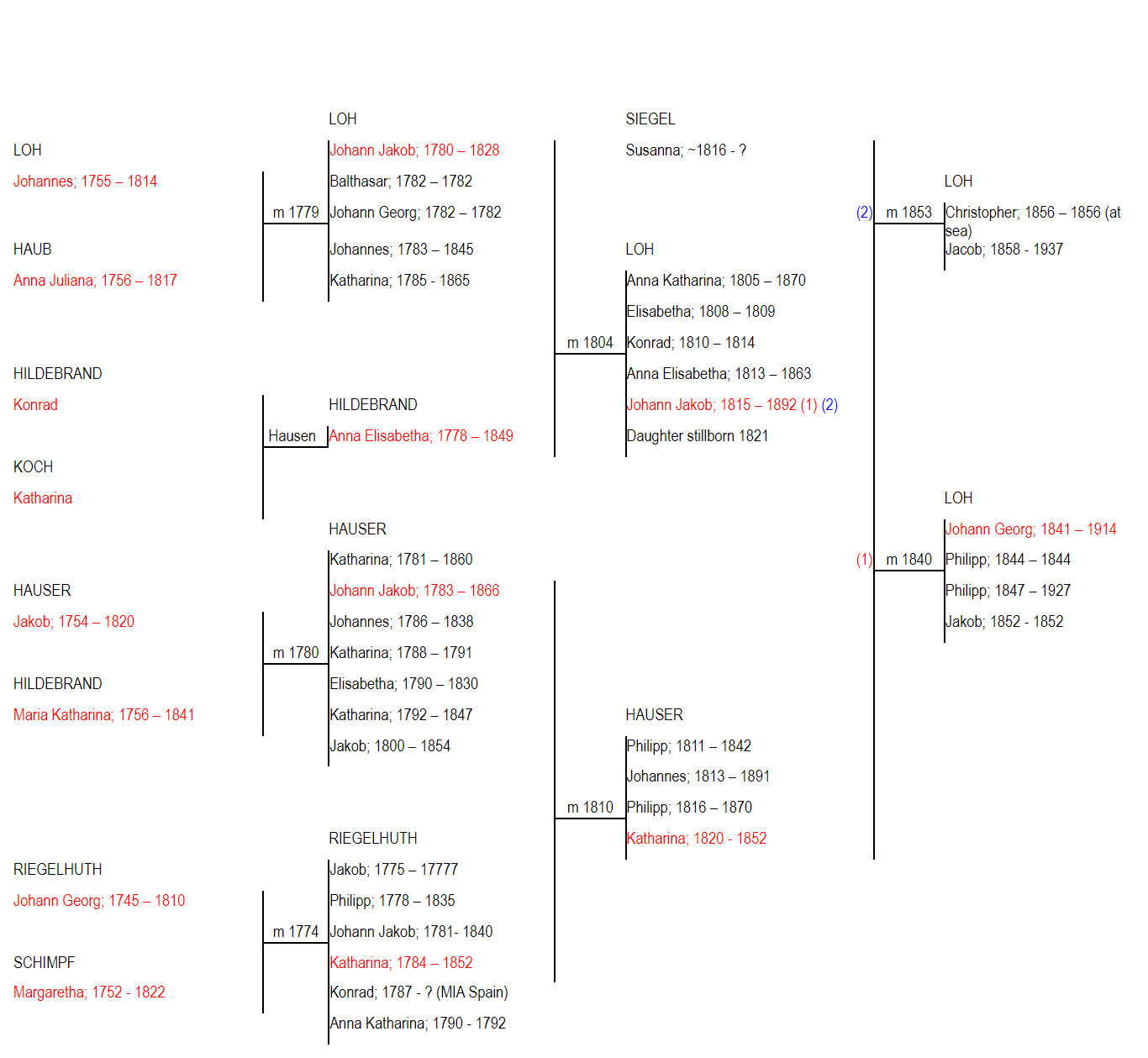Johann Georg LOH 1841-1914
Johann Georg was the eldest of the four sons born to Katharina Häuser, wife of the linen-weaver Johann Jakob Loh II. He was born on 27th February 1841, just thirteen weeks after his parents exchanged vows before the altar in the village church in Nieder-Weisel, and was baptised the following Sunday, sponsored by a son of the village barber Konrad Bill IX. Another son, Philipp, was born three years later, but did not live. Johann Jakob then took his family to Derby in England, where work was more plentiful than in rural Germany. A third son, also called Philipp, was born there in their Walker Lane home in 1847, and the family returned home in November.
In 1852 Katharina had another son, but the birth was very difficult and the baby died a week later, and the mother five days after that. Johann Jakob went back to Derby with Johann Georg. On 8th February 1853 he married Susanna Siegel from the village of Ostheim, 3 km south of Nieder-Weisel; in 1854 they had a child, Susanna. Johann Jakob then decided to join the gold rush to Victoria; they sailed from Liverpool on 5th July 1856 on “Morning Light”. The 15 year-old Johann Georg showed on the passenger list as 11, so that he could travel with the parents. During the trip, Susanna gave birth to a son, Christoph, but as so often happened with confinements on board crowded vessels, the child did not live. The 2400 ton Black Ball Line full-rigger carried her 600+ passengers to Melbourne in the smart time of 76 days, reaching Port Phillip on 18th September.
Johann Jakob settled his family in Ballarat. He and Johann Georg went mining whilst Susanna set up their home. She had one more child, Jacob, born 23rd July 1858. In 1866 Johann Georg married Ellen Hannah, who was born in 1848 in Hobart to parents John Hannah and Ellen Cosgrove, who were transported there for their roles in a counterfeiting felony carried out in Manchester. On release, John brought his wife and daughters to Victoria and settled in Bendigo, where he took over the Manchester Arms Hotel; his wife died there in June 1855.
In 1867 Ellen gave birth to the first of thirteen children, Philipp Alfred. Johann Georg then moved west to the diggings at Smythes Creek, where many immigrants from Nieder-Weisel were congregated. A daughter, Mary Christina, was born there in 1869, but she died in infancy; a son, George, took her place in 1871. There was a new rush to the region north of Maryborough at that time in which Johann Georg took part. Ellen produced their third son, William Jacob, there in 1872 and then the family settled at Timor, 8 km to the north.
In the next twelve years, Ellen had seven children there – Matilda in 1874; Catherine Ellen 1876; Emily in 1878; Frederick Walter 1879; Charles Ernest 1880; Arthur Henry 1881 and John George in 1883. Emily, Frederick and John George died and were left with George (who had died in 1876) in anonymous graves in the cemetery at Timor when their parents moved away to Gippsland. Despite a couple of accidents which put him into the Maryborough Hospital for a while, Johann Georg prospected successfully and was able to buy a 13O ha property near Jeetho, on the road and rail links to South Gippsland. Here, he set up a meat production operation, including a butcher shop and slaughter-house at nearby Loch which Philipp helped him operate. He lost his son Arthur Henry in 1886 but the other children lived to adulthood and all but Catherine Ellen married; she looked after her parents in their last years.
Johann Georg and Ellen moved to Moreland; here he ran a butcher shop until his retirement. His meat processing business was very successful and, when he died in 1914, he left an estate valued at £5,000 – say, half a million 1995 dollars. He was naturalised just before the outbreak of the Great War. Ellen survived him by seven years; they are buried in Fawkner Cemetery in a well-kept grave.
View Johann Georg's Family Chart

